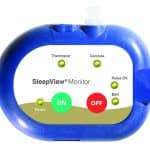Up to 40% of patients abandon CBT-I prematurely. Experts share the top reasons why and offer solutions to counter them.
By Alyx Arnett
Many patients spend countless nights tossing and turning, seeking relief from chronic insomnia, only to find a promising solution that they abandoned prematurely. This predicament surrounds cognitive behavioral therapy for insomnia (CBT-I), recommended as first-line therapy for chronic insomnia by the American College of Physicians and the American Academy of Sleep Medicine.1,2
Considered the gold standard in insomnia treatment, CBT-I is as effective as sedatives-hypnotics in the short term3 and superior in the long run, without the side effects of medication.4,5 Yet, despite its efficacy, up to 40% of patients drop out.6
Patients can be daunted by its structured approach and sometimes counterintuitive requirements. Behavioral sleep medicine practitioners and other experts share the biggest hurdles patients face in CBT-I and offer their tried-and-true tricks for keeping them committed to therapy.
Skip ahead to:
Mismatched expectations | Sleep diaries | Sleep restriction | Six rules of stimulus control
Top CBT-I Challenges for Insomnia Patients and Strategies to Overcome Them

The problem: Mismatched expectations
Patients sometimes enter CBT-I without a clear understanding of what it entails. Some expect it to be about sleep hygiene, according to Frances Thorndike, PhD, vice president of scientific affairs at Nox Health and the program creator for Somryst, the first and only US Food and Drug Administration-approved prescription digital therapeutic for chronic insomnia, which Nox recently acquired.
“It’s not about turning off the lights. It’s not about cutting caffeine. Of course, these are good things to do, but CBT-I is really a systematic and tailored behavioral treatment. It’s based on decades of research and outcomes,” she says.
Others are surprised by the absence of medication. “People get upset if they see me, and they expect they’re going to get medication. They’re not going to get medication from me to do this,” says Don Townsend, PhD, DBSM, FAASM, a clinical psychologist and sleep medicine specialist at Valley Sleep Center.
The solution: Early patient education
When Townsend begins seeing a patient, he asks them: What have you heard about CBT-I? “That’s a huge, huge thing right off the bat—expectations on what they’re going into,” he says.
Ideally, introductory information is provided by the referral source, says Townsend. He works with his partners to provide “blurbs” explaining CBT-I. That also helps weed out patients who aren’t interested in behavioral therapy. “I tell [my referral sources] all the time only to send somebody if they want to work hard and if they’re really interested in this,” says Townsend.
It’s also important to outline what patients can expect week-to-week and let them know the first several weeks won’t be easy, says Richard Blackburn, PhD, DBSM, a licensed psychologist and sleep medicine specialist at Nystrom & Associates. “But I tell them that, in the 13 years I’ve been treating insomnia using CBT-I, there’s only been a handful of people who haven’t gotten better. If you stick with the program, you will see gains,” Blackburn says.
Cali Bahrenfuss, CCSH, RPSGT, owner of Delta Sleep Coaching, agrees that early patient education is key. “Making sure the client is well informed and without any questions and has made the commitment to go through with CBT-I has been a great starting point,” she says.

The problem: Sleep diaries
Sleep diaries, used to drive the treatment algorithm, are still the gold standard for tracking sleep in CBT-I. Patients are asked to complete the diary each morning, reflecting on their sleep from the night before. The diaries involve responding to questions such as what time they got in bed, how many minutes it took to fall asleep, how many times they woke up, and how many minutes they were awake.
But for some patients, the idea of doing this is overwhelming. “It’s people who are a little bit anxious, or they’re more of a type A personality,” says Blackburn. “They want to be exact in their sleep log, and then they start fretting, ‘Was it 30 minutes that I fell asleep or 40?’”
It also takes time and effort. “The idea of tracking and tracking consistently, people are maybe resistant to that or don’t have a lot of time for that,” says Sue Goble, who supervises the behavioral health consultants providing CBT-I within the Allegheny Health Network Primary Care Institute, which recently launched a CBT-I program.
The solution: Ease their worries—or pivot as needed.
When Blackburn’s patients are anxious about completing the sleep diaries, he explains to them that, as long as they’re close in their estimates, the log will average out to be pretty accurate.
Thorndike suggests helping patients build ways to remember to complete the diary, whether by setting a reminder on their phone or asking a buddy to mention it to them. Explaining how the sleep diary drives the treatment algorithm can also help patients stick to it. “To get your sleep window expanded, you need new data. So that keeps people motivated,” Thorndike says.
Blackburn will enter his patients’ diary responses into a spreadsheet, which graphs various data points and allows patients to see how their sleep progresses. “People find those graphs hugely motivating,” he says.
In Townsend’s experience, some patients are simply too hyperfocused on the diary, which then makes them more anxious and compounds their sleep problems. In these cases, meet the patients where they are, he says, which means, for some, he doesn’t require them to complete the diary. Instead, he’ll rely on less structured reporting.
Digital methods are also an option. Goble says, “We’ve been trying to experiment with ways of collecting that information that’s not just on paper. There are a couple of app versions that we’ve been trying out with some folks who, for them, maybe tracking on paper is not ideal.”
George Wang, CEO and co-founder of Stellar Sleep, a sleep wellness mobile application, says digital programs can also give patients another method to go about receiving treatment without requiring the traditional diary. The Stellar Sleep app, for example, supports native wearable integrations to track sleep. “We automatically calculate certain metrics,” he says.

The problem: Sleep restriction
Sleep restriction—the portion of therapy in which the time spent in bed is reduced to more closely match the actual time spent asleep, thereby building sleep drive—is widely regarded as the most challenging aspect of CBT-I.
“It’s counterintuitive,” says Blackburn. “If you’re sleeping poorly, then in order to get the sleep you need, you think you need to expand your time in bed. We’re telling them to do the opposite.”
Townsend’s patients are often skeptical of sleep restriction, even though they may spend eight hours in bed with only a few hours of sleep. “But if you ask them to cut that time in bed down from spending eight hours to five or six, they will look at you like you just asked them to walk across hot coals,” he says.
Patients often fear losing more sleep than they already have, says Bahrenfuss. “When patients enter CBT-I, they are likely already exhausted, and the thought of getting less sleep can be terrifying,” she says.
Thorndike adds, “What it feels like to the patient is that I am really narrowing their amount of sleep…It’s the least popular part but perhaps the most effective part.”
The solution: Explain the rationale. Compromises are OK.
Explaining the rationale—that the goal of sleep restriction is not to take away sleep time but to take away the time spent awake while in bed—is vital, Bahrenfuss says. “There’s a big difference, and clarifying that difference is very important,” she says.
Bahrenfuss explains to her patients how sleep restriction increases sleep drive and what implementing sleep restriction may look like for them in the weeks ahead. “I’ve found that most of my patients are willing to give sleep restriction a try after proper education and encouragement,” she says.
For patients who aren’t willing, Bahrenfuss compromises. For example, if a patient is unwilling to eliminate three hours in bed, she will ask if they can do one-and-a-half. “I would rather try a slight modification than not try at all,” she says. “Oftentimes they will still feel benefits of their modified sleep restriction, and with further education and encouragement, motivation to push a little further can be achieved.”
Thorndike emphasizes that “you have to work with people in that place, or you are at risk for dropout.”

The problem: Six rules of stimulus control
The numerous rules of CBT-I—which instruct patients to lie down only when sleepy, leave bed if unable to sleep within 15 to 20 minutes, repeat this pattern as necessary, use the bed exclusively for sleep and sex, wake up at the same time daily, and avoid napping—pose additional challenges.
“The six rules of stimulus control are something that people struggle with sometimes because it requires a lifestyle change,” says Blackburn.
Patients take particular issue with the rule asking them to leave bed if they can’t fall asleep. “Patients absolutely hate that strategy,” says Townsend. “They will come up with any reason to not get out of bed.”
Blackburn says patients often find the rule counterintuitive. “They think they may fall asleep, but if they’re up, they’re not going to,” he says.
Patients also struggle with the rule that the bed is for sleep and sex only, Blackburn says. “You can’t read, watch TV, play on your phone, or do other things in bed,” he says. “It’s amazing how many people break that rule and have to change it for the program.”
The solution: Offer support and stay in touch.
Townsend estimates he can get half of his patients to buy into the six rules of stimulus control by explaining the rationale. For the other half, he will modify the strategy. “I’ll say, ‘Well, if you do not want to get out of bed, you absolutely cannot just lie there and think because that is what trains you to have that problem be perpetuated over and over,’” he says.
He’ll tell these patients to turn on the TV, read, or listen to music or a podcast. “I try to come up with any strategy that I can use in bed to make it more palatable for them, if possible,” Townsend says.
He notes the importance of ongoing communication. He gives patients his email address and tells them to reach out if they have problems. “I want people to feel like they have support while they’re doing this stuff,” he says.
Thorndike says support can also come by adding a nurse navigator—or digital navigator for an app-based program—to check in on patients. “If people struggle, we’ve got to figure out what additional support they need,” she says.
Blackburn says getting to know the patient can offer clues into their potential challenges. If a patient is depressed, for example, their bed may be their comfort zone, and they’ll struggle with using it only for sleep and sex. “Help them find structured, meaningful activities, things they can do to decompress or feel that comfort and solace that they normally feel in bed,” Blackburn says.
He also suggests his patients find outside support by talking to someone who can help keep them accountable. “I have several patients where they’ll want to go to bed early, and the partners say, ‘Nope, you’ve got another hour.’ Or they’ll say, ‘You’re starting to fall asleep. You can’t nap. Wake up.’ That motivates them,” he says.
According to Wang, “Without ongoing motivation and support, patients may lose interest or fail to fully engage with the therapeutic activities.”
Encouraging patients to build social support networks, such as joining a CBT-I social media group, can also be helpful. “Being able to talk to people who aren’t the provider to find out what other people’s experiences and struggles are is hugely beneficial,” Blackburn says.
Bahrenfuss agrees that communication is key. “Ongoing communication with the client on how they are doing and what concerns they have is vital to preventing dropouts,” she says.
References
- Qaseem A, Kansagara D, Forciea MA, et al; Clinical guidelines committee of the American College of Physicians. Management of chronic insomnia disorder in adults: a clinical practice guideline from the American College of Physicians. Ann Intern Med. 2016;165(2):125-33.
- Edinger JD, Arnedt JT, Bertisch SM, et al. Behavioral and psychological treatments for chronic insomnia disorder in adults: an American Academy of Sleep Medicine clinical practice guideline. J Clin Sleep Med. 2021;17(2):255-62.
- Smith MT, Perlis ML, Park A, et al. Comparative meta-analysis of pharmacotherapy and behavior therapy for persistent insomnia. Am J Psychiatry. 2002;159(1):5-11.
- Okajima, I, Komada, Y, Inoue Y. A meta-analysis on the treatment effectiveness of cognitive behavioral therapy for primary insomnia. Sleep Biol Rhythms. 2011;9(1): 24-34.
- Morin CM, Culbert JP, Schwartz SM. Nonpharmacological interventions for insomnia: a meta-analysis of treatment efficacy. Am J Psychiatry. 1994;151(8):1172-80.
- Koffel E, Wisdom J. 0388 Why do patients drop-out from cognitive behavioral therapy for insomnia (CBT-I)? A qualitative interview study. Sleep. 2019;42(suppl_1):A157-8.
Photo 203117712 © Lightfieldstudiosprod | Dreamstime.com







